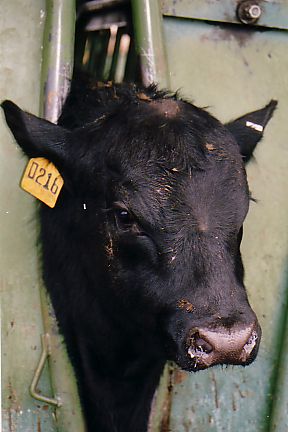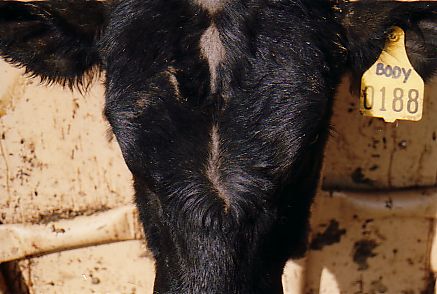Quality of Spermatozoal Morphology in Angus Yearling Bulls may be related to Hair Whorl Shape - Hair Whorls and Bull Fertility
Proceedings, Western Section, American Society of Animal Science
Vol. 53, 2002
pp. 124-126
M. Meola, T. Grandin, P. D. Burns, R. G. Mortimer
Colorado State University, Fort Collins, CO, USA
ABSTRACT: In humans, abnormal hair whorl patterns on the scalp are found in children with developmental disorders such as Down's syndrome and Prader-Willi syndrome. Previous research has shown that hair whorl position on a bovine's forehead may be related to temperament. The objective of this study was to determine the relationship between spermatozoal morphology and facial hair whorl epicenter. Breeding
Soundness Evaluations (BSE) were given to 150 Angus
yearling bulls (avg. age = 364 ± 1.4 days of age) from 3
different locations. Animals had 1 (n = 120), 2 (n = 12) whorls
or no facial hair whorl (n = 18). Bulls with no facial hair
whorls were not included in the analysis. Facial hair whorls
were categorized by 2 distinct characteristics: having a round
epicenter or having a non-round epicenter. Bulls with 1 or 2
facial hair whorls with a round epicenter had a higher
percentage of morphologically normal spermatozoa (79 ± 1.5%) than
bulls with 1 or 2 facial hair whorls with a non-round epicenter (71 ± 2.1%; P=0.005). Age of bull did not have a significant effect on percentage of normal spermatozoa (P = 0.80). Bulls with facial hair
whorls with a round epicenter were more likely to have satisfactory spermatozoal morphology scores (70% morphologically normal spermatozoa ) than bulls with facial hair whorls with non-round epicenters (P 0.002). Eighty-two percent of bulls with facial hair whorls with round epicenters had satisfactory spermatozoal morphology scores, while
only 57% of bulls with facial hair whorls with non-round epicenters had satisfactory morphology scores. It is possible that a facial hair whorl could be used as a visual aid in determining the quality, of spermatozoal morphology either during or prior to a BSE.
Introduction
Facial whorl position on the forehead of cattle has been correlated with temperament (Grandin et al., 1995; Tanner et al., 1995; Randle, 1998; Lanier et al., 1999) and may be of value in selective breeding for a calm temperament (Grandin et al., 1994). Abnormally placed or absent scalp whorls have been associated with abnormal brain development in humans (Samlaska et al., 1989). Abnormal hair whorl patterns are found in children with developmental disorders such as Down's syndrome and Prader-willi syndrome (Smith and Gong, 1973, 1974).
It is possible that hair whorl characteristics may also correlate with
scrotal circumference, spermatozoal motility, or spermatozoal morphology - the parameters measured in Breeding Soundness Evaluations (BSE). This theory is based on the fact that the patterning of hair follicles and testicular development occur at approximately the same time during gestation. Patterning of hair follicles occurs at 10-18 weeks after fertilization (Wunderlich and Heerema, 1975),while testicular development begins at 8 weeks after fertilization and is
complete at 16 weeks (Gilbert, 2000).
The primary purpose of this study was to determine the relationship between hair whorl characteristics and various parameters looked at during a BSE. The facial hair whorl is a readily visible physical trait present from birth, which if correlated to breeding soundness may be used as a visual indicator.
Materials and Methods
Animals. One hundred fifty purebred Black Angus yearling beef bulls at 2 locations in Colorado and 1 location in Wyoming were given a BSE. Locations in Colorado were the Colorado State University Agricultural Research Development and Education Center in Ft. Collins (n = 44 bulls; avg age = 367 ± 1.5 days of age) and the Colorado State University Eastern Colorado Research Center in Akron (n = 59; avg age = 374 ± 2.5 days of age). The Wyoming location was the Colorado State University John E. Rouse Beef Improvement Center in Saratoga (n = 47; avg age = 350 ± 1.3 days of age). Data were collected during the spring and
summer of 2001. The evaluations were performed by the attending veterinarian at each location.
Breeding Soundness Evaluation. All bulls passed a physical exam prior to collection. Scrotal circumference was measured to the nearest 0.5 cm. using a scrotal measuring tape (Scrotal Tape, Lane Manufacturing Inc., Denver, Colorado) as described in Ball et al., (1983). Samples were collected into either plastic test tubes or a Styrofoam cup, depending on veterinarian preference. A drop of semen was then placed directly on a microscope slide and covered with a coverslip, so motility could be assessed. Veterinarians were careful to preserve the temperature of the sample so that motility would be accurate. Another slide was made using an eosin-nigrosin stain so morphology could be
assessed (Ball et al., 1983). A second morphology slide was made and analyzed at a later date in our laboratory to get a more accurate measurement of spermatozoal abnormalities.
In the laboratory, 100 spermatazoa cells per slide were counted under a light microscope at 1000x to determine the percent normal cells in a sample (Bearden and Fuquay, 2000). This measurement was taken twice and then averaged to get the most accurate result possible. Statistical studies have shown that little precision is gained by counting more than 100 cells per slide (Bearden and Fuquay, 2000). An observer that was blind to hair whorl data evaluated spermatozoal morphology.
Facial Hair whorls. At the time of the BSE, an observer drew facial hair whorls for each bull. Hair whorls were placed into two categories according to whether they had a round epicenter or a non-round epicenter. Hair whorls were also classified into 2 extreme groups: 1) bulls that had perfect round spirals with rotation or 2) bulls that had facial whorls with a line that was longer than the diameter of the bull's eye.
Statistical analysis. Data was first analyzed using correlations in the
Proc Corr procedure of SAS version 8. Breeding Soundness Evaluation and hair whorl data were also analyzed using the Proc Mixed procedure of SAS version 8 and chi-square procedure of SAS version 8.
Results and Discussion
Bulls with 1 or 2 facial hair whorls with a round epicenter had a higher percentage of morphologically normal spermatozoa (79 ± 1.5%) than bulls with 1 or 2 facial hair whorls with a non-round epicenter (71 ± 2.1%; P = 0.005). Age did not have a significant effect on percentage of normal cells (P = 0.80). A higher percentage of bulls with facial hair whorls with a round epicenter were more likely to have satisfactory spermatozoal morphology scores (70% morphologically normal spermatozoa) than bulls with facial hair whorls with non-round epicenters (P = 0.002). Eighty-two percent of bulls with facial hair whorls with round epicenters had satisfactory spermatozoal morphology scores, while only 57% of bulls with facial hair whorls with non-round epicenters had satisfactory spermatozoal morphology scores.
Twenty-nine bulls had perfect round spirals with rotation and 18 bulls had facial whorls with epicenters longer than the diameter of the bull's eye. Bulls with facial hair whorls that were perfect round spirals had a higher percentage of morphologically normal spermatozoa
(77% ± 2.5) than bulls with very long epicenters (69% ± 3.2; P = 0.05).
Bulls with a facial hair whorl that is a perfect round spiral are more likely to have satisfactory spermatozoal morphology scores than
bulls with long epicenters (P = 0.02). Eighty-three percent (24 out of 29) of bulls with perfect round facial hair whorls had satisfactory morphology scores, while only 50% (9 out of 18) of bulls with very long epicenters had satisfactory scores.
The results of this experiment show a relationship between the hair whorl epicenter shape and spermatozoal morphology score. Bulls with a normal, round epicenter were more likely to have a higher percentage of morphologically normal spermatozoa were also more likely to have satisfactory spermatozoal morphology scores than bulls with facial hair whorls with non-round epicenters. An even greater number of morphology failures were found in bulls with grossly abnormal hair patterns with long lines than in bulls with non-round epicenters.
The morphology of seminal spermatozoa is the end result of a highly complex process of cellular modifications occurring during speriniogenesis (Auger et al., 2001). Many factors influence male reproductive health (Boisen et al., 2001). Studies have shown that prenatal exposure to environmental agents can affect the development of the male genital tract (Boisen et al., 2001). Due to these and other factors influencing spermatozoal morphology, it is not possible to
determine the exact relationship that it has to facial hair whorl
shape. Further studies must be done to further examine this
correlation and determine if there is a genetic or environmental
connection.
Implications
Facial hair whorl assessment is a quick and easy method that can be performed by a veterinarian or producer. It may be possible to use facial hair whorl patterns as a visual indicator of spermatozoal morphology prior to administering the Breeding Soundness Evaluation.
 |
Bull with a normal round spiral hair whorl on his forehead. Bulls with normal round spirals had a higher percentage of normal spermatozoa and may be more fertile. |
| Bull with a distorted abnormal line pattern on his forehead. Half the bulls with this pattern failed the breeding soundness exam and are likely to be less fertile. The spot on the top of the head is a bald spot from rubbing. |
 |
Literature Cited
Auger, J., F. Eustache, A.G. Andersen, D.S. Irvine, N. Jorgensen, N. E. Skakkebaek, J. Suominen, J. Toppari, M. Vierula, and P. Jouannet. 2001. Spermatozoal morphological defects related to enviromnent, lifestyle and medical history of 1001 male partners of pregnant women from four European cities. Hum. Reprod. 16:2710-7.
Ball, L., R.S. Ott, R.G. Mortimer, and J.C. Simons. 1983.
Manual for Breeding Soundness Examination of bulls.
Bearden, J.H. and Fuquay, J.W. 2000. Applied Animal
Reproduction. 5th ed. Prentice-Hall, Englewood Cliffs,
NJ.
Boisen, K.A., K.M. Main, E. Rajpert-de Meyts, and N.E.
Skakkebaek. 2001. Are male reproductive disorders a
common entity. Ann. N.Y. Acad. Sci. 948:90-99.
Gilbert, S.F. 2000. Developmental Biology. 6th ed. Sinauer
Associates, Inc., Sunderland, MA.
Grandin, T. 1994. Solving livestock handling problems. Vet.
Med. October: 989-998.
Grandin, T., M.J. Deesing, J.J. Struthers, and A.M. Swinker.
1995. Cattle with hair whorl patterns above the eyes are
more behaviorally agitated during restraint. Appl. Anim.
Behav. Sci. 46:117-123.
Lanier, J.L., T. Grandin, R. Green, D. Avery, and K. McGee.
1999. A note on hair whorl position and cattle temperament
in the auction ring. Appl. Anim. Behav. Sci. 73:93-101.
Randle, H.D. 1997. Facial hair whorl position and temperament in cattle. Appl. Anim. Behav. Sci. 56:139-147.
Samlaska C.P., W.D. James and L.C. Sperling. 1989. Scalp
whorls. J. Am. Acad. Dermatol. 21:553-6. Clue to early fetal development. J. Pediatr. 83:374-380.
Smith, D.W. and B.T. Gong. 1974. Scalp-hair patterning: Its
origin and significance relative to early brain and upper
facial development. Teratology. 9:17-34.
Tanner, M., T. Grandin, M. Cattell, and M.J. Deesing. 1992.
The relationship between facial hair whorls and milking
parlor side preference. J. Anim. Sci. 72: 207.
Wunderlich, R.C., and Heerema, N.A. 1975. Hair crown
patterns of human newborns. Clin. Ped. 14:1045-1049.
 Click here to return to the Homepage for more information on animal behavior, welfare, and care.
Click here to return to the Homepage for more information on animal behavior, welfare, and care.


